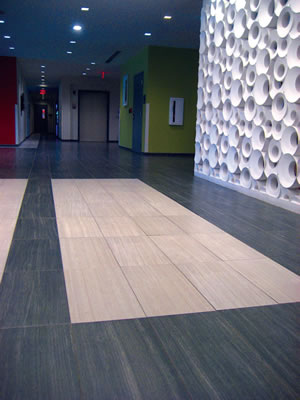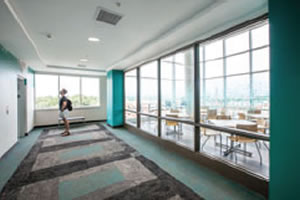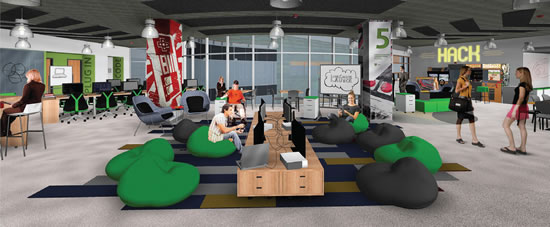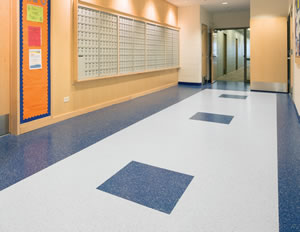What Floor Do You Live On?

PHOTO © SCOTT BERMAN
The disparate floors throughout the corridors, common
areas, lounges, classrooms
and bedrooms of Howard University’s
recently constructed College Hall student
residence in Washington, DC, are telling in some respects.
There are choices that speak to some
of the expectations, needs and varieties
of carpet and flooring products and types
being specified and installed widely in
student residences today.
At College Hall, those choices include
tile in formal, tasteful colors in the entrance lobby and corridor; carpet tile in warm
tones coordinate with soft seating in student
lounges; similar carpet tile interspersed
with bold strips of color in student room
corridors; crisp carpet and vinyl plank in
student rooms; and attractive, high-gloss
vinyl composite tile (VCT) in classrooms.
Changing Trends
That variety of uses and interior designs
also suggest how student residences have
changed, and continue to change. Take, for
another example, Lassonde Studios at the
University of Utah. Lassonde, designed by
EDA Architects, is a student residence just
constructed and in the process of opening
for the semester at this writing. As EDA’s
Amanda Jones sees it, the new residence
is “a new building type that integrates
student living space with maker spaces.”
Those maker spaces, or workshops, are interdisciplinary
and are integrated through
the building’s common and residential
areas, purposely blurring the boundaries
between each space.
The most prevalent floor? Polished
concrete.

PHOTO © EDR
Jones explains that the concrete flooring
“provides an excellent and durable surface
for the anticipated near-constant reconfiguration
of wheeled furniture and heavy
equipment (and) will hold up well to the
high traffic of furniture, equipment and
students.” There are other considerations
as well, centering on how spaces will be
used today and tomorrow. According to
Jones, “In addition to adding to the industrial
garage feel, the concrete also helps
to distinguish between areas that will be
continuously repurposed and areas that are
intended to be more static and less flexible. As the concrete ages and receives a patina
of use, it will add to the industrial look and
creative atmosphere of the design.”
There are additional choices throughout
Lassonde. Carpet tile is limited to student
rooms and circulation areas that serve those
rooms, while luxury vinyl tile resembling
wood planks appears in three colors in bathroom
and locker areas. Finally, area rugs
also appear “alongside the polished concrete
in order to provide some visual ‘softness/comfort’ and aesthetic depth. These rugs
were selected for their flexibility in design
and overall durability,” Jones adds.
With such an array of student resident
spaces come evolving expectations about
flooring. Yet, some constants remain, and
it comes as no surprise to facilities managers
or others that expectations still center
on things like durability, maintenance, the
environment and budget. However, there’s
increasing awareness today about how
those aspects are interwoven.

PHOTOS © LASSONDE ENTREPRENEUR INSTITUTE AT THE UNIVERSITY OF UTAH
Nora, for one, cites rubber flooring as a
case in point: arguing that it can be quite
durable while not requiring “sealants, wax
or other coatings to maintain its original
appearance,” says Tim Cole, vice president
of Marketing for nora systems, Inc. He
explains that such flooring “can be cleaned
simply, in some cases with just water, which
means large areas of dormitories do not
need to be closed while wax is stripped,
reapplied and allowed to dry. The absence of
harsh chemicals and the fact that the floor is
GREENGUARD Gold Certified for low VOC
emissions also support sustainability goals.”
Keeping It Green
Selecting flooring congruent with
today’s keen environmental awareness can
be less of a burden than it is an opportunity.
In the view of James Kenner, vice
president of Design for student residence
developer EdR, flooring products that
limit environmental impact “do not in any
way limit our creativity.” For example, the
developer is now installing 100-percent
recycled-content carpet tiles wherever
carpet is specified in student residence
projects. Going this route “allows us the
ability to create looks, mix materials and
use patterns simply not possible with traditional
rolled carpet,” says Kenner.
EdR also uses durable porcelain tile and
antimicrobial vinyl tile plank for flooring
throughout its student residences, and the
variety speaks to the changing spaces and
uses found in the building type. Kenner explains,
“Many more amenities are offered in
what has become a much more competitive
market,” and with more amenities come the
need for flooring to match. There are “golf
simulators, poolside decks, community
kitchens, hi-tech laundry rooms, ultramodern
fitness centers,” and in response,
“recycled products — rubber, wood,
plastics, even abandoned fishing nets — all come into play when specifying flooring for
these areas,” he says.

PHOTO © NORA
EdR has variously applied this strategy in
student residences and other campus projects,
such as at the University of Kentucky.
There, Kenner explains, “all flooring materials
specified are from recycled products.”
As for budget, Kenner acknowledges
that going with recycled flooring products
“is a little more expensive upfront but saves
us money in the long run.” Also in terms of
cost, nora’s Cole cites the need for flooring
that can be installed efficiently and swiftly
in student residence projects — to achieve
that: flooring products with environmentally
friendly adhesive layers, resistance
to high moisture and the ability to be
installed atop existing surfaces.
Weather Considerations
Each locale has its own factors to consider.
At New York’s Syracuse University,
for example, high-volume traffic and
tough winters impacted the university’s
choice of flooring across 22 residence
halls, according to nora. In response, officials
went with a “rubber flooring to cover
dorm entrance areas, corridors, common
spaces and stairwells,” the manufacturer
indicates. The choice has stood up well to
weather and traffic since being installed
seven years ago.
Finally, there’s an interweaving of
other factors: aesthetics and competition.
Cole puts it this way: “As institutions of
higher education compete for students, the
appearance of campus facilities and the
services they offer are becoming increasingly
important.”
It follows that carpet and flooring are
also becoming increasingly important.
SOME THOUGHTS ABOUT THE PROCESS OF FINDING, SELECTING AND INSTALLING CARPET AND FLOORING IN TODAY’S STUDENT RESIDENCES:
- Consider flooring’s role as a focal point of
an interior design scheme. What kind of
statement can be expressed, what tone or
mood suggested, for what spaces?
- “Look at total cost of ownership,” says
nora systems’ Tim Cole, who points out
that depending on maintenance needs and
durability, “a floor with the cheapest price
tag sometimes comes with a much higher
total cost of ownership.”
- Think through how floors can contribute to
the flexibility of spaces today and tomorrow.
That is, how may the use and furnishings of
those spaces change in the future, and how
can flooring not only accommodate those
changes, but also withstand the moving
that so often comes with such changes?
This article originally appeared in the issue of .